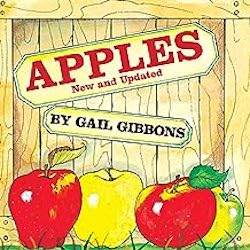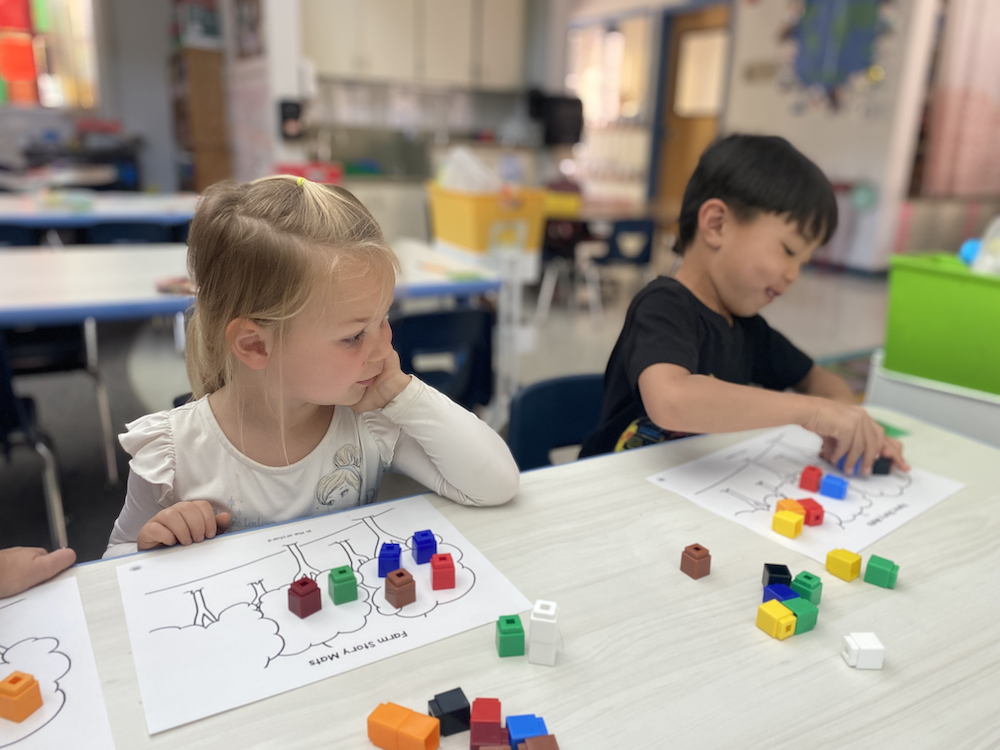Agricultural Literacy Curriculum Matrix
Lesson Plan
Crops on the Farm
Grade Level
Purpose
Students investgate different food crops and how they grow. Grades PreK-K
Estimated Time
Materials Needed
Circle Time: Crops Grow
- Apples by Gail Gibbons
- Vocabulary Development Photo Cards (Prior to the lesson, cut and laminate the cards for future use)
- Crops Grow Anchor Chart (Prior to the lesson, copy the framework onto the easel pad)
Literacy: Harvest Time! Three-Step Sequencing
Math: Farm Stories
- Farm Story Mats (orchard and field)
- Counters (unifix cubes, mini erasers, etc.)
- Farm Story Problem Cards
Science: Desktop Crop
- Clean lid (from a peanut butter jar or soup cup), 1 per group
- Paper towel, 1 per group
- Mustard seeds
- Aluminum foil to block light
- Spray bottle with water
- Desktop Crop Observation Sheet
Vocabulary
bean: a seed, or the pod containing seeds, of various climbing plants, eaten as a vegetable
crop: a cultivated plant that is grown and harvested, especially a grain, fruit, or vegetable
fruit: the part of a plant that develops from the flower and contains the seeds of the plant
grain: the edible seed or seed-like fruit of grasses that are cereals (such as wheat, corn, and rice)
nut: a fruit consisting of a hard or tough shell protecting a kernel which is usually edible
vegetable: any edible part of a plant that does not contain seeds
Background Agricultural Connections
In an effort to simplify the idea of where food comes from, many early learners are implicitly taught that most farms look like the farms of the past: a single family living and working on a farm to provide for their day-to-day needs. In the past, the entire family would work on the farm and there was always work to be done. Typically, these farms would grow many different fruits and vegetables, with a big barn that housed a variety of livestock animals: a small brood of chickens, a horse, several cows and pigs, and a small herd of sheep. The family's food came from their own farm. Although some farms are still like that, today we get most of our food from much larger farms—still family owned—that specialize in growing one type of food. There are egg farms, dairy farms, almond farms, and apple farms. Modern farms require specialized knowledge, skills, and machinery in order to survive the global marketplace.
This lesson is part of a series called, Life on the Farm. The remaining lessons can be found at the following links:
- All Kinds of Farms
- Animals on the Farm
- Crops on the Farm
- Machines on the Farm
- Thank You Farmers
Food crops are plants that people grow to eat. There are many different types of food crops, like fruits, vegetables, grains, nuts, and beans.
Fruits: Fruits come from flowering plants. They start as tiny flowers and then grow into fruits. For example, apples grow on apple trees. They get big and juicy as they ripen.
Vegetables: Vegetables can come from different parts of plants. Carrots and potatoes grow underground, while lettuce and spinach grow as leaves above the ground. We eat these parts of the plants.
Grains: Grains are seeds that grow on tall plants like wheat, rice, and corn. Farmers plant these seeds in fields, and when they're ready, they are harvested and used to make foods like bread, pasta, and cereal.
Nuts: Most nuts we eat grow on trees, but peanuts grow underground.
Beans: Beans grow on plants. They come in different colors and shapes, like green beans, black beans, and kidney beans. We can cook and eat them.
Engage
- Provide each student with a blank piece of paper and crayons. Ask them to draw a picture of a farmer taking care of plants.
- Invite the students to share their pictures with the class and identify the plants the farmer is growing.
- Explain to the students that they will be learning about different types of plants farmers grow for food.
Explore and Explain
Circle Time: Crops Grow
 Read the book, Apples by Gail Gibbons.
Read the book, Apples by Gail Gibbons.- After reading, review the Vocabulary Development Photo Cards.
- Show the cards to the children and say the name of each photo on the card. Encourage the children to repeat the vocabulary words after you.
- Ask the children to identify the object or action on the card and describe what it is or does.
- Possible prompts:
- Orchard: An orchard is a place where lots of trees stand in rows. It is where farmers plant and tend fruit and nut trees like apples, peaches, and almonds. What are some other crops that grow in an orchard?
- Field: A field is a big open space of land where farmers plant seeds and grow crops like corn, wheat, and vegetables, and it's an important place where plants get the sun, rain, and nutrients they need to grow big and strong. What are some other crops that grow in a field?
- Blossom: Blossoms are the small flowers that appear on fruit or nut trees. When trees have blossoms, bees visit the flowers to collect nectar, and while doing so, transfer pollen from one flower to the next, helping the tree produce fruits or nuts. What sweet food do we get from bees?
- Grocery Store: A grocery store is a place where we can buy foods and drinks that are grown or made on farms, such as fruits and vegetables from orchards and fields. What grocery stores are in our community?
- Transport: Transport means moving crops and animals from farms to different places like grocery stores or factories where they can be made into the foods we love to eat. This can be done by trucks, trains, ships, or planes. Have you ever seen trucks moving crops or animals? What were they carrying?
- Dormant: This word describes when a tree is alive but not actively growing. What do you notice about this photo of a dormant tree?
- Complete the Crops Grow Anchor Chart. Teacher note: Prior to the lesson create a framwork on an easel pad using the Crops Grow Anchor Chart template. As you review the key points and interact with students, draw and write their ideas on the anchor chart. Hang the chart in a prominent location in the classroom where students can easily refer to it throughout the unit.
Literacy: Harvest Time! Three-Step Sequencing
- Introduce the concept of three-step sequencing. Tell the students they are going to practice putting a series of events in the right order. Introduce the terms first, next, and last. Give some simple examples, such as getting ready for school or making a peanut butter and jelly sandwich.
- Show the students the apple. Invite them to come up with a three-step sequence for apple production. For example, first they are grown on a tree, next they are harvested, and last they are transported to a grocery store.
- Use the Harvest Time! Sequencing Cards to practice three-step sequencing for a variety of agricultural crops. Students can work independently, in pairs, or as a larger group. After they put the cards in the right order, ask them to orally tell the story on the cards.
- Invite the students to give an example of a three-step sequence they saw today or one they can think of on their own. Remind them that crops provide us with food and that farmers work hard to produce food for us to enjoy.
Math: Farm Stories
 Show the students the Farm Story Mats (orchard and field) and the counters. Explain that the mats represent different kinds of farms and the counters represent crops growing on the farms. Invite the students to discuss the similarities and differences between the two scenes.
Show the students the Farm Story Mats (orchard and field) and the counters. Explain that the mats represent different kinds of farms and the counters represent crops growing on the farms. Invite the students to discuss the similarities and differences between the two scenes.- Give each student a turn to pick a counter from the pile and place it on the mat wherever they like. Encourage them to imagine what kind of crop they are planting, and to place the token in a spot that would be suitable for that crop to grow.
- Once all the students have placed a token on the mat, explain that you will be giving instructions for them to add or remove counters from the mat. Encourage them to listen carefully and follow the instructions.
- Use the Farm Story Problem Cards to guide the students through the activity. Once the students get the hang of it, encourage them to suggest their own story problems.
Science: Desktop Crops
 Explain to the students that farmers take care of plants so that they can grow big and healthy. Farmers take care of lots of plants, sometimes even thousands of plants, which we call a crop. The crop needs food, water, and light. Farmers work really hard to make sure the plants are healthy, and when the plants are ready, they harvest the crop. For example, farmers might grow corn as a crop to sell as food for people or animals. Or they might grow cotton as a crop to make into clothing.
Explain to the students that farmers take care of plants so that they can grow big and healthy. Farmers take care of lots of plants, sometimes even thousands of plants, which we call a crop. The crop needs food, water, and light. Farmers work really hard to make sure the plants are healthy, and when the plants are ready, they harvest the crop. For example, farmers might grow corn as a crop to sell as food for people or animals. Or they might grow cotton as a crop to make into clothing.- Tell the students that they will plant a desktop crop to see what plants need and how they grow from seeds.
- Take a clean lid from a peanut butter jar or use a plastic soup-cup lid.
- Fit the paper towel into the lid, covering any tiny holes.
- Moisten the paper towel with a spray bottle filled with water. You don't want it too wet.
- Sprinkle seeds on the paper towel.
- Cover the lid with a thick piece of aluminum foil to block the light and allow seeds to germinate.
- Check your garden every day until you see little shoots growing, then remove the cover. Once the seeds have sprouted, place them in a sunny location and water regularly.
- Have the students record their observations on Days 5, 10, and 15 on their Desktop Crop Observation Sheet.
Evaluate
After conducting these activities, review and summarize the following key concepts:
- Food crops are plants that people grow to eat.
- There are many different types of food crops, like fruits, vegetables, grains, nuts, and beans.
- Farmers take care of their crops by providing the right amount of food, water, and light.
Recommended Companion Resources
Author
Organization
| We welcome your feedback! If you have a question about this lesson or would like to report a broken link, please send us an email at matrixelearning@gmail.com. If you have used this lesson and are willing to share your experience, we will provide you with a coupon code for 10% off your next purchase at AgClassroomStore. |
